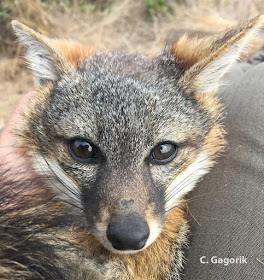 |
| photo courtesy of S. Baker, NPS |
Meet M181! This young male island fox on Santa Rosa Island was fitted with a radio collar funded by YOU.
Channel Island National Park biologists have been fitting radio collars on individual foxes, conducting health checks, and counting island foxes throughout August.
These new and refurbished radio collars will provide information on island fox location and survival for the next 2–3 years.
Each radio collar has a signal at a specific individual frequency that is picked up by a radio receiver. The fox does not hear the collar's signal.
Biologists can only hear the signal if they have a receiver tuned to the correct frequency and are within a specific proximity to the fox.
Radio collars are small and light weight so they do not bother the island fox. Each radio collar is fitted with a "two-finger fit" so that it is not too tight, yet not so loose that it might get caught on something.
Watch and Listen to the video below
WATCH as M181 is released back into the wild after his check-up and radio collar fitting.
LISTEN for the beeps from the receiver as the biologist checks the functioning of the radio collar.
Island Foxes on San Miguel Island will be getting their radio collars next.
Catalina Island foxes will be getting their radio collars and vaccinations soon.
You can still help fund a refurbished radio collar $220
for Catalina Island.
Donate Today








